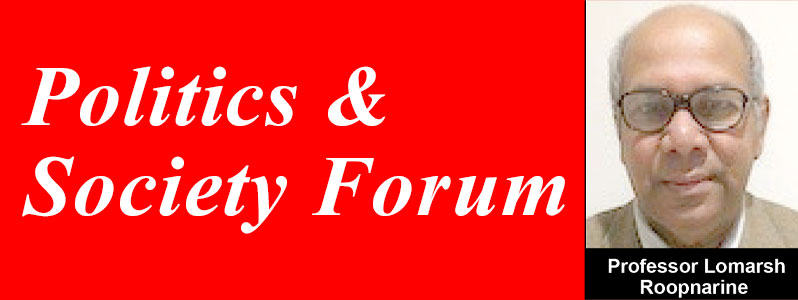WITHOUT a doubt, the Caribbean is home to a unique diversity of languages brought about by European colonisation as well as the in-migration of individuals in the modern period. Generally speaking, there are two types of languages in the Caribbean: standard and non-standard. These language types have been at the core of the Caribbean regional speaking experience for centuries. I predict they will continue.
A standard language is a written version of a language that has achieved widespread acceptance as the proper form. English is a standard language as it is used as the language of government, formal education, and commerce in Guyana, for instance. A non-standard language is when the grammar is undeveloped and inconsistent. Pidgin and Creole are considered non-standard languages but they are not inferior to standard languages, an ongoing misconception. They are instead make-shift or mixed languages derived from limited contact between people of politically unequal influence (Europeans and Africans during slavery). Berbice Dutch Creole in Guyana, which is now extinct, was based on a West African language and Dutch. Many Creole languages have nonetheless evolved into the mother tongue or first language of Caribbean people. For most Guyanese, for example, Pidgin is their first language.
There are other language terms such as dialects, vernacular, and slang that deserve some clarification. Taken together, these language terms reflect how people speak in a geographical area of the Caribbean as well as their social status in society. For example, in the French Caribbean, people speak a combination of standard and non-standard language called Patois or Creole. Additionally, slang is an informal vocabulary developed by members of a subculture who seek solidarity and identification, emerging from conflicts in beliefs and values with the dominant culture. One can think here of the ‘Dread Talk by Rastafarians.
What is so unique about Caribbean people is that they engage in code-switching which is a process of changing from one language to another as the situation requires, whether from one language to another or from one dialect of a language to another. For example, my name is Lomarsh, but me barn de adad side of de countree. Personally speaking, code-switching is colourful and it is my favourite part of the Caribbean language. I use it quite a bit whenever I am in the Caribbean including my home village in Guyana. Unfortunately, code-switching is rare in the United States unless you are in a subcultural environment.
Now, let us examine exactly where the standard and non-standard languages are spoken in the Caribbean. The Guianas and the island of Dominica are the only places where the Amerindian languages or Pre-Columbian languages are spoken. In Guyana, there are at least nine indigenous languages, a status Guyanese should be proud of. The standard languages of the Caribbean by country are as follows: Spanish is spoken in Cuba, Dominican Republic, Puerto Rico, the Central, and South American rimland regions while English is spoken in the Commonwealth Caribbean (eastern Caribbean), Jamaica, Guyana, Belize, and the Virgin Islands. French is spoken in Haiti and the French Overseas Department such as Guadeloupe, Martinique, and French Guiana. Dutch is spoken in Suriname and the Netherlands Antilles, although English is replacing Dutch as the main language in the Antilles.
There are also non-standard Creole languages which are spoken on a daily basis. In the Commonwealth Caribbean “English Creoles” are spoken (Bajan, Crucian on St. Croix), in the French Caribbean, French Creoles are spoken while in Haiti the Creole language has official status. French Creole is also spoken in English-speaking Dominica and St. Lucia because of French colonisation of these two islands before the English took them over. In Suriname, an Afro Dutch Creole with an English base called Takie-Takie or Sranan Tongo is spoken while in the Dutch Antilles an Afro-Spanish-Portuguese-Dutch-based Creole is spoken called Papiamentu. The latter has acquired official status. Spanglish (a combination of Spanish and English) is spoken in Puerto Rico, although some linguists believe Spanglish does not have a Creole base.
Most standard and non-standard languages in the Caribbean were introduced, formed and evolved before the abolition of slavery in the nineteenth century. The institutionalisation of the indenture system to supplant slavery as a labour source brought new waves of languages to the Caribbean, notably, Chinese, Portuguese, Hindi derived Bhojpuri, Suriname Javanese, and Arabic in Guyana, Trinidad, and Suriname. The Chinese and Portuguese languages are gone, but Hindi and Suriname Javanese (different from Indonesia) have survived mainly in Suriname. Moreover, the intra-regional migration in the modern period has led to the spread of other languages in the Caribbean. Guyanese Pidgin is spoken in Antigua while Spanish is spoken in the Virgin Islands. English is widely spoken in Suriname. One suspects that it is a matter of time that Spanish and Portuguese will be spoken beyond their current usage in Guyana due to the in-migration of Venezuelans and Brazilians (lomarsh.roopnarine@jsusms.edu).


.jpg)











